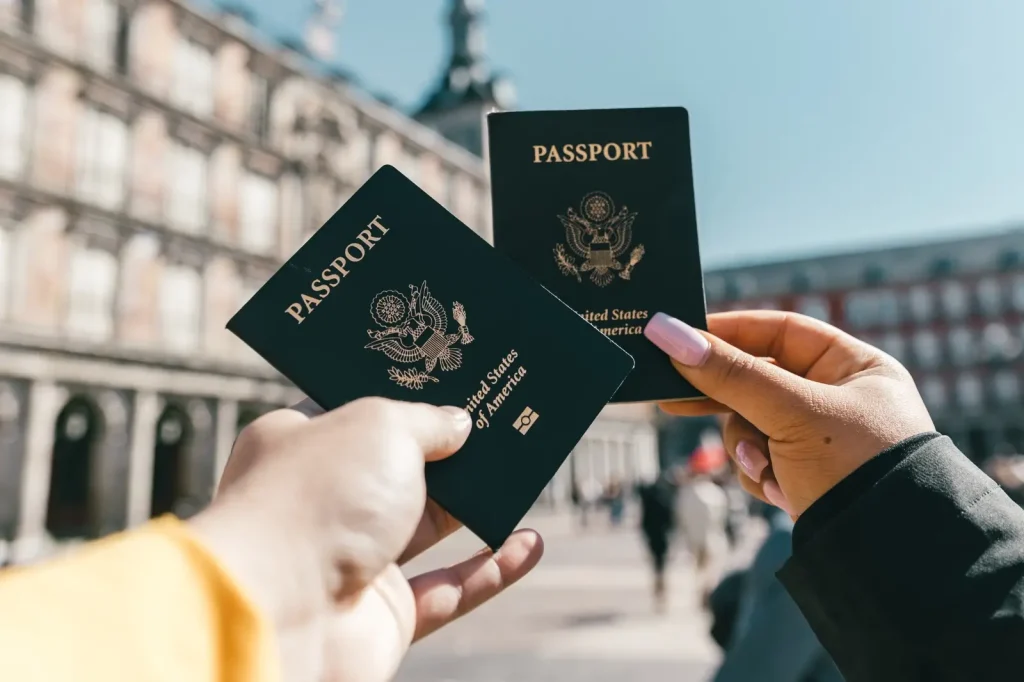
Important USCIS Policy Change: Stricter Rules for Marriage-Based Green Card Applicants as of August 2025
September 18, 2025
Sham Marriage Myths vs. Facts: How to Prove a USCIS Bona Fide Marriage for Green Card
October 21, 2025
Important USCIS Policy Change: Stricter Rules for Marriage-Based Green Card Applicants as of August 2025
September 18, 2025
Sham Marriage Myths vs. Facts: How to Prove a USCIS Bona Fide Marriage for Green Card
October 21, 2025
Fiancé Visa vs. Spouse Visa: Which Marriage Visa Is Right for Your Relationship?
You're committed to building a life together in the United States, but you face a crucial decision that will shape your entire immigration journey: Should you pursue a K-1 fiancé visa or wait and apply for a CR-1 / IR-1 spouse visa instead?
This isn't just about paperwork preferences. Your choice affects everything from how long you'll be separated to your spouse's rights and status once they arrive in America. It impacts your financial planning, career decisions, and family timeline in ways that many couples don't fully understand until they're deep into the process.
The decision becomes even more complex when you consider that both pathways lead to the same destination—permanent U.S. residency—but through very different routes with distinct advantages and trade-offs.
This guide examines the strategic differences between these U.S. immigration visa options, helping you understand not just the mechanics of each process, but the real-world implications for your relationship and future plans.
Need U.S. Immigration guidance you can trust? Contact Strang Immigration today to get expert legal advice specific to your unique situation.

Comparing the K-1 Visa vs IR-1 / CR-1 Visa
Both the fiancé visa and spouse visa are designed to lead to permanent residency in the United States, but success isn't guaranteed with either path. This is why expert legal advice is crucial.
One route prioritizes speed but creates a complex two-step process with multiple approval points. The other takes longer upfront but delivers immediate security and legal certainty once approved.
Understanding these fundamental differences is crucial because there's no going back once you've started down either path. Let’s explore the differences more closely:
The K-1 Fiancé Visa: Fiancé First, Then Adjust
The K-1 fiancé visa creates a two-phase immigration process. Your fiancé enters the United States on a temporary visa specifically for marriage, then transitions to permanent residency through a separate application after your wedding.
This approach prioritizes speed of reunion but requires navigating two distinct legal processes. Your fiancé will have limited rights during the initial period and must successfully complete the second phase to achieve their immigration goals.
The CR-1 / IR-1 Spouse Visa: Direct to Permanent Residency
Spouse visas take a different approach entirely. Your already-married spouse applies directly for permanent residency from abroad and receives a green card immediately upon entering the United States.
This strategy involves a longer initial wait but eliminates the uncertainty and complexity of a two-step process. Your spouse arrives as a permanent resident with full rights and privileges from day one.

Visa Application Timeline Considerations
Understanding the true timeline implications requires looking beyond simple processing periods to consider your overall immigration strategy.
K-1 Fiance Visa Process
Current K-1 processing averages 10 to 14 months from petition filing to visa issuance. However, this represents only the first milestone in your immigration journey.
After marriage, your spouse must file Form I-485 for Adjustment of Status, which can take upwards of 2 years depending on your location. During this period, your spouse can apply for work authorization, but they cannot travel internationally without advance parole approval.
The complete timeline from K-1 filing to green card typically spans 18 months to 3+ years, with your spouse in a transitional status for much of that time.
CR-1 / IR-1 Spousal Visa Process
Spouse visas wait times generally process within 12 to 24 months, delivering permanent residency immediately upon completion. Your spouse receives work authorization, travel freedom, and legal certainty the moment they enter the United States.
While the initial wait may be longer, the immigration process concludes definitively with visa issuance. No additional applications, interviews, or uncertainty periods follow.

Navigating the Marriage Visa: How Fiancé and Spouse Visas Affect Real Life
The practical differences in your spouse's legal status create significant implications for career planning, family decisions, and peace of mind. These are technical distinctions that shape your daily life and long-term planning in ways many couples don't anticipate.
K-1 Visa Status Limitations and Benefits
K-1 visa holders enter the United States in a highly restricted status. They cannot work, travel internationally, or change their status to anything other than permanent resident through marriage to their petitioning citizen.
After marriage, the Adjustment of Status process creates a period of legal vulnerability. While work authorization applications are typically approved, travel requires advance parole, and the green card application could theoretically be denied. This transitional period affects employment opportunities, as some employers hesitate to hire individuals whose long-term status remains pending. Professional licensing, educational enrollment, and other life decisions may be complicated by temporary status.
However, the K-1 visa offers faster initial reunion, typically processing within 10 to 14 months. You can plan your wedding in the United States and navigate the green card process together.
IR-1 / CR-1 Spouse Visa Limitations and Benefits
A spouse visa allows the foreign spouse to become a permanent resident immediately upon entry. They can work for any employer, start businesses, travel internationally, and make long-term commitments without immigration-related restrictions.
This immediate status certainty provides tremendous practical advantages. Your spouse can begin their career, pursue education, apply for professional licenses, and fully participate in American life without waiting for additional approvals. The psychological benefits are equally important. Permanent resident status eliminates the anxiety and uncertainty that characterizes the Adjustment of Status period.
However, spouse visas typically take 12 to 24 months to process, meaning longer initial separation. Any case complications must be resolved through consular processing abroad rather than domestically. Higher upfront costs and the requirement to be legally married before applying also present limitations.

Comparing the K-1 Fiancé Visa and CR-1 / IR-1 Spousal Visa: Financial and Practical Implications
The true costs of your visa choice go far beyond the filing fees you'll pay USCIS. You need to consider lost income, delayed career opportunities, and unexpected expenses that can significantly impact your family's financial planning.
K-1 Visa Application Process: Financial Considerations
While K-1 petitions have lower initial filing fees, the total cost often exceeds spouse visa expenses when accounting for Adjustment of Status fees, work authorization applications, travel document fees, and potential legal representation for two separate processes.
The work authorization delay can create significant financial hardship for families depending on dual incomes. Even after approval, some career opportunities may be limited during the transitional status period.
Travel restrictions during Adjustment of Status can create unexpected expenses if family emergencies arise abroad or if maintaining international business relationships is important to your family's financial stability.
CR-1 / IR-1 Application Process: Financial Considerations
Higher upfront costs for spouse visas are offset by immediate work authorization and the elimination of duplicate fees and applications. Your spouse can begin contributing to family income immediately upon arrival.
Immediate travel freedom prevents the costs and complications associated with emergency travel during the Adjustment of Status period. Professional opportunities remain unrestricted, potentially leading to better long-term career outcomes.

Fiancé or Spouse Visa: Decision Factors Beyond Processing Times
Your choice should align with your relationship circumstances, priorities, and long-term goals rather than focusing solely on reunion speed.
When K-1 Visa Is the Right Choice
The K-1 visa serves couples well when reunion timing outweighs other considerations. If you're not yet married and want to celebrate your wedding with U.S.-based family and friends, the K-1 provides that flexibility.
Some couples prefer handling the green card process together in the United States, where they can work directly with trusted immigration attorneys and attend interviews jointly. The K-1 also works well for couples comfortable with a transitional period and confident in their ability to navigate the two-step process.
Consider the K-1 if your fiancé's current situation abroad is particularly difficult or if extended separation creates significant personal or professional hardships that outweigh the disadvantages of transitional status.
When CR-1 / IR-1 Visa For a Spouse Offers Better Strategy
Spouse visas provide superior outcomes for couples prioritizing legal certainty and immediate integration into American life. If your spouse has career opportunities that require immediate work authorization or if travel flexibility is essential for business or family reasons, the CR-1 / IR-1 route offers clear advantages.
Couples with previous immigration complications, those concerned about the two-step process risks, or families where the foreign spouse will be the primary income earner often benefit from the direct permanent residency approach.
The spouse visa also makes sense for couples already married who don't need the wedding flexibility that the K-1 provides, or for those who prefer a single, complete immigration process over managing multiple applications.

Visa and Marriage Risk Assessment and Mitigation
Each pathway carries distinct risks that should factor into your decision-making process.
K-1 Risk Factors
The two-step process creates multiple opportunities for complications. Changes in circumstances between the K-1 approval and Adjustment of Status filing can affect the case outcome. Job loss, relationship issues, or other life changes during the transitional period can create vulnerabilities.
The 90-day marriage requirement eliminates flexibility for unexpected circumstances. Illness, family emergencies, or administrative delays cannot extend this deadline, creating pressure that some couples find stressful.
Work authorization delays can strain family finances, and travel restrictions may prevent handling family emergencies abroad during the Adjustment of Status period.
CR1/IR1 Risk Mitigation
The single-step process eliminates many risks associated with transitional status. Once approved, your spouse's immigration process is complete, providing certainty and stability.
However, longer initial separation periods can strain relationships, and any case complications become much more difficult to resolve because you'll be handling them from different countries. If USCIS requests additional evidence or the embassy raises concerns, you and your spouse must navigate these challenges while separated, often across time zones and without the ability to attend meetings or interviews together.

Professional Guidance for Complex Immigration and Green Card Decisions
Immigration decisions have long-lasting consequences that extend far beyond processing times and filing fees. The wrong choice can create months of additional delays, financial hardship, or missed opportunities that affect your family for years.
Every couple's situation involves unique factors that generic advice cannot address. Previous immigration history, financial circumstances, career considerations, and family obligations all influence which pathway serves your interests best.
At Strang Immigration Law, we help couples evaluate their options comprehensively, considering not just the immediate immigration process but the long-term implications for their life in America. Our attorneys provide the strategic analysis you need to make informed decisions that align with your goals and circumstances.
Don't base this crucial decision on processing time estimates or general advice.
Contact us today for a consultation that examines your specific situation and provides the personalized guidance you need to choose the right path for your future together.
ABOUT US

We are dedicated to protecting your legal rights at every stage of the process. Discover for yourself how our immigration attorneys can help you obtain a successful outcome



